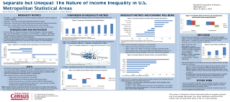
An official website of the United States government
Here’s how you know
Official websites use .gov
A .gov website belongs to an official government organization in the United States.
Secure .gov websites use HTTPS
A lock (
) or https:// means you’ve safely connected to the .gov website. Share sensitive information only on official, secure websites.
-
//
- Census.gov /
- Library /
- Census Working Papers /
- Separate but Unequal: The Nature of Income Inequality
Separate but Unequal: The Nature of Income Inequality in U.S. Metropolitan Statistical Areas
Separate but Unequal: The Nature of Income Inequality in U.S. Metropolitan Statistical Areas
Introduction
Income Inequality as a concept is straightforward. Are there a lot of haves and have-nots or do most people have close to the same amount of money? However, the measurement of income inequality is not so straightforward. There are a number of different income inequality metrics available and the choice of a particular metric alters the conclusions about the level of income inequality and the relationship between income inequality and economic well-being. Eight inequality metrics are calculated and compared to one another in order to examine how the use of a particular metric affects the understanding of economic well-being in U.S. metropolitan statistical areas (MSAs).
Data from the 2014 American Community Survey are used to calculate seven after-tax household income inequality metrics. Household after-tax income includes income from all sources as well as transfer payments (SSI, social security, and public assistance) and subtracts federal and state taxes using NBER’s TAXSIM program.1 This income variable is adjusted by the size of the household using a three-parameter equivalence scale and deflated by MSA cost of living using factors developed by the Bureau of Economic Analysis (BEA).
The income inequality metrics:
* Gini Index = a statistical measure of income inequality ranging from zero, perfect equality, to one, perfect inequality.
* Palma ratio = ratio of top 10% share of total income to lowest 40% share of total income
* Household income ratios of selected percentiles:
- 80-20 ratio = 80th percentile income limit divided by 20th percentile income limit
- 90-10 ratio = 90th percentile income limit divided by 10th percentile income limit
- 90-50 ratio = 90th percentile income limit divided by 50th percentile income limit
- 50-10 ratio = 50th percentile income limit divided by 10th percentile income limit
- 99-90 ratio = 99th percentile income limit divided by 90th percentile income limit
The eighth metric measures educational inequality, which is a Gini index based on educational attainment instead of income.
I explore two research questions. First, how do these different metrics of income inequality compare to one another and how does the use of a particular metric change our view of income inequality in MSAs? Second, how are the income inequality metrics related to economic well-being? Most importantly, how does the use of a particular metric change our understanding of the relationship between inequality and economic well-being?
Share
Some content on this site is available in several different electronic formats. Some of the files may require a plug-in or additional software to view.
 Yes
Yes
 No
NoComments or suggestions?


Top

